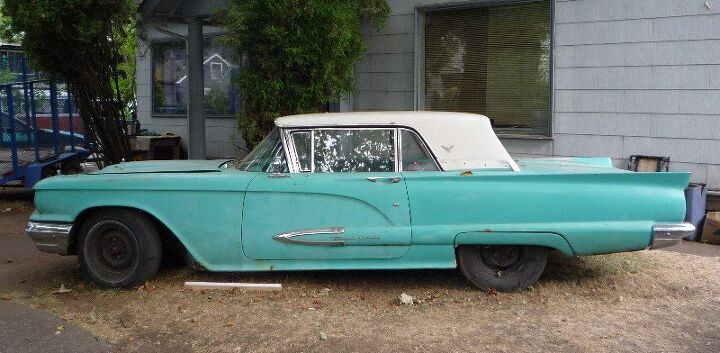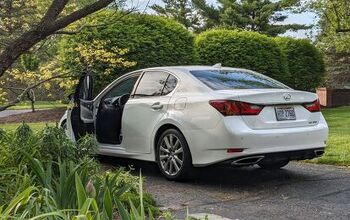Curbside Classic: Five Revolutionary Cars – No. 3 – 1958 Ford Thunderbird

NB: The car pictured here is a 1959 Thunderbird, but my article is about its near identical 1958 predecessor, because of its historical significance. I hope the dissonance won’t upset the purists here. I could never tell them apart as a kid anyway.
Behold the mythical winged dream machine. The 1958 Thunderbird was the embodiment of the dream where everyday folks would fly above the humdrum of dull workaday existence and dowdy sedans. Once the realm of the privileged few, luxury and exclusivity was now in the grasp of every hard working dreamer; after all, the T Bird was still a Ford. If Ol’ Henry could fulfill the once unthinkable dream of putting every American on wheels, then surely Hank II and his Whiz Kids could do the same with wings. And for a dozen years or so, the Thunderbird soared, and revolutionized the industry by creating the attainable personal luxury genre. Perhaps it tried to fly too high, or the dream changed, because it soon fell back to earth. And after it crashed, and had its wings tacked onto a blinged-out Torino, a piece of the American dream died with it.
If this series of revolutionary vehicles had been of just two cars, the T-Bird and the VW would be it. They each carved out major new segments of the popular-priced market, on the opposite ends of the spectrum. And like their respective buyers, they are each other’s polar opposites; ying/yang, right brain/left brain, thrifty/exuberant, grounded/aspiring. They foreshadowed the complete fragmentation of the modern marketplace, which previously had been dominated by full-sized cars. The industry has never been the same since. Revolutionary enough?
The Thunderbird was born as a response to the ’53 Corvette and other sports cars. Its ’55-‘57 incarnation as a two-seater may have had a sporty air but it was all pretense; it was the antecedent to the long line of Mercedes SL soft-roadsters. It handily outsold the ‘Vette, by a huge margin too. Lesson learned: Ford would forever leave Chevy to fight for a share of the marginal sports car market. Its first taste of the personal-luxury market was juicy, and Ford was hooked.
But if the Thunderbird was to really fly, to truly be the winged aspiration of late-fifties suburban optimism, it needed to be a four-seater: a social vehicle. The T Bird was there to take your impressed friends for steaks at the supper club after mai tais in the Polynesian-themed rec room of your new rancher. Or the kids to the game while Mommy was shopping in her Country Squire. Two seaters are intrinsically anti-social; the province of sports car fanatics, boors, or the snooty upper crust. Even if nobody ever sat in the back of the T-Bird, it spoke of the possibility of being invited in and sharing the dream.
The new ’58 “Squarebird” was revolutionary in its development and production too. Reflecting a new style over function paradigm, for the first time ever, the role of designers and engineers was reversed. The Thunderbird was fully styled before it was engineered; Detroit’s longstanding hierarchy was turned on its head.
It was also the first vehicle built at Ford’s new Wixom MI plant, designed specifically to assemble big unibodies, revolutionary in its own right. Unless I’ve committed a fatal error, that would make the T Bird the first unibody of the Big Three. The same plant also built the beautiful ’61 and up suicide-door Continental. The two of them shared more than meets the eye. The Continental was a direct descendant of the losing proposal by Elwood Engel for the design competition for the ’58 T Bird. A highly questionable decision too; the Vietnam War wasn’t the only guilt Robert McNamara took to his grave.
Speaking of styling, probably the less said from me the better, lest I offend the lovers of these beasts. I spoke my piece about Ford’s late-fifties styling themes in our ’59 Ford CC, and it set off the usual debates and catcalls. But all the same issues apply: the upper half lacks proper proportions and looks like it’s melting into the lower half. The front end looks like a cross between the Batmobile and a big-mouth bass. The rear end is an exuberant display of protrusions, curves and afterburners, and the best angle from which to view this rocket ship. ‘Nuff said.
When I first arrived in the states in 1960, on my mile-long walk to second grade, there was one of these Squarebirds and a similar vintage Corvette along the way to distract me. The “Vette was easy for me to “get”; all buff, and with that sexy big ass. The T Bird was an enigma. Don’t get me wrong; I obsessed on it, especially that interior, which looks like a cross between a ski-boat’s cockpit and a late-forties Hollywood space-ship control console. Compared to all the dumpy Ramblers and Larks along the way, the T-Bird was the highlight of my day, every day. But I struggled to figure out what Joe Oros and his stylists were communicating. I learned English quick enough, but Squarebirdese was a bitch. Oh well; it sure kept my attention. I’m sure the owner wondered what all those smudges and drool were on his side window every morning.
Speaking of consoles, the ‘Bird’s was the mother of them all; and for a good reason. The Thunderbird may have flown metaphorically, spiritually and mythically, but in reality, it was highly earthbound: barely five inches of ground clearance on this low-flyer, when new. After a few years of spring sag; well, this one here looks an empty creeper would barely fit under there. Anyway, the console covered a drive shaft that was practically at elbow level.
The engine compartment was a snug affair too. It was a bit of a shock the first time I looked in one; I was so used to the typical barn-sized engine rooms of tall fifties sedans. The T-Bird was truly futuristic in this regard: portending the nightmare engine compartments of the seventies. Under that big flat air cleaner sat Ford’s brand-new 352 cubic inch (5.8 liter) FE engine. Fed by a big Holley four barrel carb, it was rated at a then impressive 300 horsepower. About the same as a new Caddy, but the T-Bird was closer in price to a Fairlane than a Coupe DeVille.
The 352 not enough? Order up the MEL 430 cubic inch (7 liter) monster borrowed from the Lincoln, the biggest engine available in the land, if not the world. The extra fifty horsepower and truckloads of torque probably made it one of the fastest sleds in its day. Handling, such as it was to start with, undoubtedly didn’t benefit from all that extra iron over the front wheels. It’s all Thunderbird mythology anyway, because mighty few MELs were ever actually shoehorned into that cozy engine compartment.
The ’58 model was a bang up success, despite a short production year and the lack of a rag top until almost the end. But that was only the beginning: 1959 saw 67k sold, and in 1960, some 93k. That was almost five times the best year of the two-seat T-Bird, and ten times of the Corvette. 1960 marked the apex of the T-Birds flight trajectory – except for a blip in 1964 – and a long glide into the depths of the seventies ensued. We’ll hold our noses and talk about the T-Bird’s demise and resurrection as a zombie another time.
Amazingly, or not, it took GM five years to take the Thunderbird seriously and launch some real competition. The ’63 Riviera was a gem, but sold at half the T-Bird’s rate. Ford established a pretty solid beachhead in the luxo-coupe wars, at least for a while. And it taught Ford a hell of a lesson: attack GM from the sides, not head on. A lesson that Ford repeated more than once again.
The T-Bird’s luxo-coupe market dwindled away, as dreams and fads inevitably do. New dreams were invented by the Mad Men to take its place, and as long as there are buyers willing to fall for their seductive inventions, the mythical Thunderbird clapping its wings can be heard.

More by Paul Niedermeyer
Latest Car Reviews
Read moreLatest Product Reviews
Read moreRecent Comments
- VoGhost Interesting comments. Back in reality, AV is already here, and the experience to date has been that AV is far safer than most drivers. But I guess your "news" didn't tell you that, for some reason.
- Doc423 Come try to take it, Pal. Environmental Whacko.
- 28-Cars-Later Mazda despite attractive styling has resale issues - 'Yota is always the answer.
- 28-Cars-Later Try again.
- Doc423 It's a flat turn, not banked, which makes it more difficult to negotiate, especially if you're travelling a little too fast.







































Comments
Join the conversation
my dad was a pilot, lt. col. in the reserves, an engineer at olin mathisen owner of winchester firearms he had the pipe, the bug eye sunglasses drove a 60 bird light blue with red interior coolest car in the hood at the time awesome interior and dash
Paul, This '58 T-Bird pictured has to be the ugliest one I have ever seen. My Dad had a '58 T-Bird graphite gray body with white top. It was a high curb appeal vehicle everywhere we went. Low to the ground. Great road car on 500m trips to Lake Michigan. The AC could freeze meat if you left on max cold. Powerful for its day. It weighed 4200 pounds and was built like a Lincoln. Very quiet for it's day. I always thought the interior was a treat to ride in. The '59 added the chrome arrow head on the doors. The '60 had three tail lights each side vice two, no chrome on doors. It is possible to critique anything. I rode in some late sixties BMW and Porsche rides that made me US car buyer for life. The old tech was truly ugly, but at the time we did not know the future and had no other choices. Your bashing of the old is with today's frame of reference. However, I am very entertained by your writings, don't stop! Edco